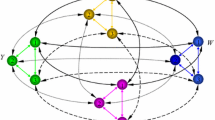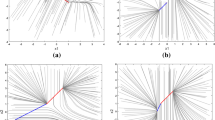Abstract
In this paper, we analyse the equilibria of neural networks which consist of a set of sigmoid nonlinearities with linear interconnections,without assuming that the interconnections are symmetric or that there are no self-interactions. By eliminating these assumptions, we are able to study the effects of imperfect implementation on the behaviour of Hopfield networks. If one views the neural network as evolving on the openn-dimensional hypercubeH = (0, 1)n, we have the following conclusions as the neural characteristics become steeper and steeper: (i) There is at most one equilibrium in any compact subset ofH, and under mild assumptions this equilibrium is unstable. In fact, the dimension of the stable manifold of this equilibrium is the same as the number of eigenvalues of the interconnection matrix with negative real parts. (ii) There might be some equilibria in the faces ofH, and under mild conditions these are always unstable. Moreover, it is easy to compute the dimension of the stable manifold of each such equilibrium. (iii) A systematic procedure is given for determining which corners of the hypercubeH contain equilibria, and it is shown that all equilibria in the corners ofH are asymptotically stable.
Similar content being viewed by others
References
Gantmacher R 1959Matrix theory (New York: Chelsea) vol. 1
Hopfield J J 1982 Neural networks and physical systems with emergent collective computational capabilities.Proc. Natl. Acad. Sci. (USA) 79: 2554–2558
Hopfield J J 1984 Neurons with graded response have collective computational capabilities like those of two-state neurons.Proc. Natl. Acad. Sci. (USA) 81: 3088–3092
Hopfield J J, Tank D W 1985 ‘Neural’ computation of decision optimization problems.Biol. Cybernet. 52: 141–152
Hirsch M W 1987 Convergence in neural nets.Proc. Int. Joint Conf. on Neural Networks (New York: IEEE) vol. 2, pp. 115–125
Hirsch M W, Smale S 1974Differential equations, dynamical systems and linear algebra (New York: Academic Press)
Tank D W, Hopfield J J 1986 Simple ‘neural’ optimization networks: AnA/D converter, signal decision circuit, and a linear programming circuit.IEEE Trans. Circ. Thy. CAS-33: 533–541
Vidyasagar M 1991 Improved neural networks for analog to digital conversion.Circuits, Syst. Signal Process. 10: (to appear)
Author information
Authors and Affiliations
Rights and permissions
About this article
Cite this article
Vidyasagar, M. An analysis of the equilibria of neural networks with linear interconnections. Sadhana 15, 283–300 (1990). https://doi.org/10.1007/BF02811326
Issue Date:
DOI: https://doi.org/10.1007/BF02811326




